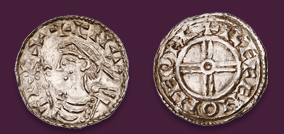
Auction: 25007 - … British and World Coins and Medals featuring The Oriole Collection of Gold and Silver English Coins
Lot: 454
PCGS SP58 | Poland, Augustus II "Mocny" (1697-1706 / 1709-1733), temp. Great Northern War (1706-1709), "Restoration to the Polish Crown" Gold Medal of 50-Ducats, 1709, by Heinrich Paul Groskurt, Court Medallist at Dresden, after the Battle of Poltava and Treaty of Thorn, D G AVGVSTVS II REX POLON ELECT SAXON, rev. FVLCITVR PRVDENTIA in scroll, Column entwined with a serpent, Elbe landscape in the background, above a ribbon with the inscription, edge plain, 173.481g, 12h (Heinrich Lübeck [1737], p. 56, no. 2; Kluczycki [1835], - cf. 133; Dassdorf -, cf. 1174-1176; Numophylacii Ampachiani [1835], -, cf. 15099-15101; Hutten-Czapski 2704 [AE, 66mm], cf. 2705 [AE, 44mm]; Göttingen University MA 0866 [Sn; 65mm]; Krakow MNK VII-Md-791 [AR; 80.8mm; 229.85g]; Dresden State Art Collection 3692), with a few light cabinet marks, otherwise colourfully if softly cabinet toned, a pleasingly bold extremely fine, believed UNIQUE in this metal and for this remarkable weight with no comparable in private or institutional collections, and thus one of the most important pieces of Polish numismata to re-surface at global auction in living memory!, in PCGS holder, graded SP58 (Cert. #55968366)
Provenance
NAC 3 (Zurich), 17 September 1990, lot 836*
https://www.pcgs.com/cert/55968366
Augustus II (1670-1733), known as "Augustus II Mocny", meaning "the Strong", was King of Poland and Grand Duke of Lithuania from 1697 to 1733. He was simultaneously Elector of Saxony as Frederick Augustus I from 1694 until his death in 1733. The second son of Elector John George III of Saxony, Augustus succeeded as elector in 1694 after the death of his elder brother from smallpox.
After the death of John III Sobieski of Poland, Augustus became one of eighteen candidates to the throne of the Polish-Lithuanian Commonwealth. The death of Sobieski marked the end of a twenty-two-year reign and a period marked within the Commonwealth as one of great stability. He was a popular ruler, remembered as a great military commander and noted for his victory at the Battle of Vienna in 1683 over the neighbouring Ottoman Empire.
To secure the Polish throne Augustus converted from Lutheranism to Catholicism in 1697, which was necessary to rule the predominantly Catholic Polish-Lithuanian Commonwealth. He won a contested election, defeating other candidates including the French-backed Prince of Conti.
In 1573 the Polish-Lithuanian Commonwealth adopted an elective monarchy system, meaning when the monarch died the throne was not automatically passed to their legitimate heir. Instead, the entire nobility, known as 'szlachta', assembled to vote for their next ruler and therefore elected the king to act as a servant to the nation. The szlachta, became the dominant social class within the commonwealth which was able to exercise political rights and social power. However, this echelon of society differed from the nobility of other western-European countries. As well as the power to select their monarch and control legislature they were also understood to be equals before the king rather than subservient to him. One factor which influenced this was the fact their land was in full ownership rather than feudal tenure. This political culture of egality came to be embedded as a constitutional principle known as Golden Liberty.
This system ensured that monarchs could not build up hereditary dynastic power, each monarch had to negotiate and promise to respect noble privileges, and foreign powers could be waged against each other (candidates often came from different European dynasties). One of the problems this caused was that there was often little incentive to invest in long-term reforms, knowing their sons would not automatically inherit.
This was a frustration of Augustus II, as he could not guarantee his son's succession and had limited ability to strengthen the monarchy or implement lasting changes. His attempts to strengthen royal authority and reform the commonwealth met fierce resistance. The Saxon-Polish personal union also drained Polish resources, as Augustus often prioritised Saxon interests. His son Augustus III did eventually win election in 1733, but only after the War of the Polish Succession.
The defining conflict of Augustus' reign was the Great Northern War against Sweden's Charles XII. It was a major conflict that reshaped the balance of power in Northern and Eastern Europe. At the war's outset, Sweden under King Charles XII was the dominant military power in the Baltic region but faced a coalition of enemies including Russia under Peter the Great, Denmark-Norway under Frederick IV, and Saxony-Poland-Lithuania led by Augustus II. This triple alliance hoped to take advantage of the young and inexperienced 18-year-old King of Sweden. The war did ultimately end with Sweden's defeat and marked the rise of Russia as the new dominant power in the Baltic sea region.
Augustus played a significant but troubled role in the conflict. He was one of the key instigators of the war, forming an alliance with Denmark and Russia in 1699 to challenge Swedish supremacy. However, Charles XII defeated him repeatedly and by 1706 Augustus was forced to renounce the Polish throne and break his alliance with Russia after Sweden invaded Saxony. He only returned to power after Charles XII suffered a catastrophic defeat at the Battle of Poltava in 1709, although he remained a relatively minor player for the remainder of the war.
The Battle of Poltava was a resounding Russian victory over Sweden and in turn made Russia the leading political voice within the conflict. In October 1709 the Treaty of Thorn was signed between Augustus and Peter the Great, which in effect revived their earlier alliance of 1699 and worked to unite them against their common rival, Sweden. The treaty marked a key moment in the shifting balance of power in Eastern-European. Although it resulted in Augustus being reinstated to the throne there were several clauses that greatly favoured Russia and fostered the nation's powerful rise. Augustus was beholden to tackle enemies of Russia within Poland; in addition, Russia was able to hold onto previously lost territories and the highest offices in the Polish-Lithuanian Commonwealth were occupied by nobles supportive of the Tsar.
This medal was struck in 1709 to commemorative Augustus' return to the Polish throne. An act of propagandistic power for a figure now of somewhat diminished influence. Further, the commissioning of such a medal is evidence of Augustus' well-regarded patronage of the arts and architecture.
Dresden was the capital of his creative endeavours as he sought to transform it into a "Florence on the Elbe". He commissioned the construction of Zwinger Palace, regarded for its renowned baroque style designed by Matthäus Daniel Pöppelmann. He also commissioned Dresden's cathedral and the reconstruction of the Japanese Palace to house his vast porcelain collection. Augustus was fanatically devoted to porcelain, which Europeans called "white gold", and for many years he had been a great collector of Asian ceramics. He was later introduced to Johann Friedrich Böttger, a young alchemist, who claimed to be able to produce porcelain. After further experimentation and the royal patronage and investment of Augustus II the Meissen Porcelain factory was established in 1710. The factory was the first to successful produce European porcelain, ending dependence on Chinese imports, and to this day is a highly regarded name within the craft.
Most appropriately Dresden too is the birthplace of this medal, where it was brought into creative fruition by the court medallist Heinrich Paul Groskurt. Meissen, in a similar vain to this medallic issue, was used by Augustus to promote his image. One of the earliest models to be made by the factory was a figure of their patron, which shows him in a powerful stance wearing armour and a victorious laurel wreath. This piece was reproduced in both porcelain and stoneware in a range of colours. Further, within a year of the factory opening Augustus was using its wares as diplomatic gifts. The first of which was presented to Frederick IV of Denmark, one of Augustus' allies, in 1711. This was also a tradition carried on by his son, Augustus III, who in the 1730s sent Meissen gifts to England in an attempt to secure support in the War of the Polish Succession.
Subject to 20% VAT on Buyer’s Premium. For more information please view Terms and Conditions for Buyers.
Estimate
£30,000 to £50,000
Starting price
£25000




